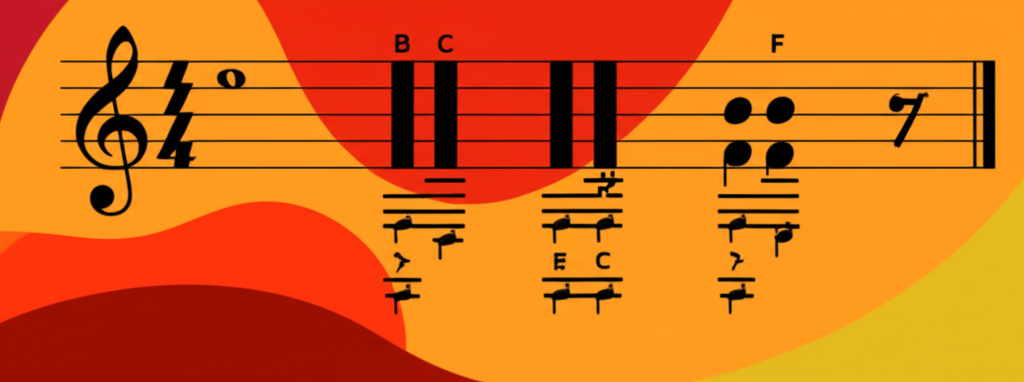The Dominant Seventh Chord: Music's Engine of Tension and Release
If there's one chord that acts as the engine of Western music, it's the dominant seventh. You've heard its tense, unresolved sound countless times in everything from Bach to blues, and from pop to jazz. It's the musical equivalent of a cliffhanger, creating a powerful expectation that pulls the listener toward a satisfying conclusion. Built on the fifth degree of a scale, this four-note chord is essential for establishing a key, driving harmonic motion, and creating powerful emotional arcs in music.
The Anatomy of a Dominant Seventh Chord
A dominant seventh chord is built from a simple, powerful formula: a major triad with an added minor seventh. Let's break down its four notes using G7 (the dominant of C major) as our example:
- Root: The foundation of the chord. (G)
- Major Third: Three semitones above the root, giving the chord its major quality. (B)
- Perfect Fifth: Seven semitones above the root, providing stability. (D)
- Minor Seventh: Ten semitones above the root, adding the characteristic tension. (F)
Here is a G7 chord, which functions as the V7 chord in the key of C Major.
The Heart of Tension: The Tritone
What gives the dominant seventh its signature restless quality? The secret lies in the tritone—an interval spanning three whole tones (or six semitones) . In a G7 chord, the tritone occurs between the major third (B) and the minor seventh (F).
This interval is highly dissonant, creating an instability that our ears instinctively want to hear resolved. This powerful pull is the primary source of the chord's harmonic function.
Harmonic Function and Resolution
The dominant seventh's primary job is to resolve to the tonic (I) chord. This V7-I movement, known as an authentic cadence, is the strongest way to establish a key. The resolution feels so final because the dissonant tritone resolves inward and outward by step.
- Leading Tone (the 3rd): This note is only a semitone below the tonic. It has a powerful tendency to resolve up to the tonic root. (In G7, B resolves up to C).
- Chordal Seventh (the 7th): This note naturally resolves down by step to the third of the tonic chord. (In G7, F resolves down to E).
Watch and listen to how the individual notes of the G7 chord resolve smoothly to the C major chord. The lyrics below the notes indicate the resolution path.
Common Progressions in Action
Because of its powerful function, the dominant seventh is a cornerstone of many common chord progressions.
- ii-V7-I: The most important progression in jazz. It creates a smooth, logical path to the tonic. (In C Major: Dm7 - G7 - Cmaj7) .
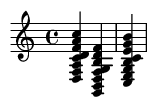
- V7/V (Secondary Dominant) : This is the "dominant of the dominant." It's used to temporarily tonicize the V chord, creating a stronger pull towards it before resolving to the tonic. In the key of C, the V chord is G. The dominant of G is D. Therefore, D7 is the V7/V. (D7 - G7 - C).
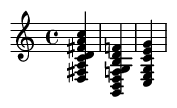
Expanding the Sound: Inversions
Like any four-note chord, the dominant seventh can be inverted by placing a note other than the root in the bass. Inversions create smoother basslines and add harmonic variety.
- Root Position: G-B-D-F (Root in bass)
- First Inversion: B-D-F-G (3rd in bass)
- Second Inversion: D-F-G-B (5th in bass)
- Third Inversion: F-G-B-D (7th in bass)
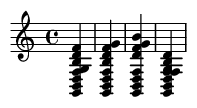
Jazz and Blues Flavor: Extensions and Alterations
In jazz and blues, the dominant seventh is a playground for harmonic color. Musicians add "extensions" (notes beyond the 7th) and "alterations" to create richer, more complex sounds.
- Extensions: The 9th, 11th, and 13th can be added to the chord for more color. A G9 chord, for example, adds the note A.
- Alterations: To increase the tension even further, jazz musicians often alter the 5th and 9th of the chord (e.g., b5, #5, b9, #9). An "altered dominant" (G7alt) is packed with maximum tension before resolving.
Here is a G9 chord, which adds the ninth (A) to the basic G7 structure.
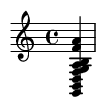
How to Practice and Master the Dominant Seventh
To truly internalize the sound and function of this chord, try these exercises:
- Ear Training: Play a V7-I cadence repeatedly on your instrument. Sing the individual notes. Then, try to identify it in songs you listen to.
- Instrumental Fluency: Practice playing dominant seventh chords and their resolutions to the tonic in all 12 keys. Work through all the inversions.
- Analyze Music: Get a lead sheet for a jazz standard or a score for a classical piece. Use a highlighter to find all the dominant seventh chords and analyze their function (e.g., V7, V7/V, etc.) .
- Improvisation: Learn the Mixolydian scale (a major scale with a flat 7th), which is the most common scale choice for improvising over a standard dominant seventh chord.
A Brief History
The dominant seventh chord didn't appear overnight. Its use evolved over centuries:
- Baroque (1600-1750): The chord was used with strict rules, almost always functioning as the V7 resolving to I.
- Classical (1750-1820): Composers like Mozart and Haydn made the V7-I cadence the absolute bedrock of their harmonic language.
- Romantic (1820-1900): The chord became a jumping-off point for greater chromaticism, with more frequent use of extensions and alterations to create dramatic tension.
- Jazz/Blues (20th Century): The dominant seventh's role changed dramatically. In blues, it can function as a stable tonic chord (I7) or subdominant (IV7), not just a chord of tension. In jazz, it became the primary vehicle for harmonic complexity and improvisation.
From its simple function as a point of tension to its complex role in modern jazz, the dominant seventh chord is a fundamental building block of music. Understanding its structure, function, and feel is a major step toward mastering harmony, composition, and improvisation.
Historical Context and Musical Significance
The dominant seventh chord emerged during the Baroque period (c. 1600-1750) as composers sought greater harmonic tension. Claudio Monteverdi's Cruda Amarilli (1605) features early functional usage, while J.S. Bach's chorales systematized its role in cadential formulas. The chord's significance lies in its acoustic properties: the tritone interval between its third and seventh creates dissonance demanding resolution. In classical tonality, it functions as the primary harmonic catalyst, establishing key centers through authentic cadences (V7-I). This "harmonic engine" principle extends beyond classical music - Beethoven's dramatic V7 resolutions in his Fifth Symphony (1808) and Schubert's song cycles demonstrate its emotional potency, paving the way for Romantic chromaticism.
Progressive Exercises
Beginner
- Build dominant sevenths from root positions: Play C major scale, construct G7 (G-B-D-F) and resolve to C major
- Cadence drills: Alternate between I and V7 chords in all major keys (e.g., C to G7, F to C7)
Intermediate
- Secondary dominants: Resolve V7/V to V (e.g., in C major: D7 [V7/V] to G7)
- Inversions practice: Play G7 in all inversions (1st: B-D-F-G, 2nd: D-F-G-B, 3rd: F-G-B-D) resolving to C
Advanced
- Tritone substitutions: Replace G7 with D♭7 in C major progression (sharing B/F tritone)
- Altered dominants: Add ♭9, #9, ♯11 extensions to V7 chords in jazz progressions
Ear Training Tips
- Tritone recognition: Isolate B-F interval in G7 chord; compare with consonant intervals
- Resolution drills: Use apps like ToneGym to practice identifying V7-I resolutions in random keys
- Blues progression immersion: Transcribe dominant seventh movements in Muddy Waters' Hoochie Coochie Man (1954)
- Voice-leading focus: Track how the seventh (F in G7) descends to third (E in C major)
Common Usage in Different Genres
Classical
Essential for perfect cadences. In Mozart's Symphony No. 40 (1788), V7-I resolutions define tonal centers.
Jazz
Foundation for ii-V-I progressions. Miles Davis' So What (1959) uses D7♯11 for modal tension.
Blues
Structural backbone: 12-bar blues uses I7, IV7, V7 (e.g., B.B. King's The Thrill Is Gone).
Popular Music
The Beatles' I Want to Hold Your Hand (1963) employs E7 resolving to A in chorus progression.
Musical Theater
Sondheim's Send In the Clowns (1973) uses secondary dominants for emotional complexity.
Online Resources
- Teoria.com - Interactive harmonic analysis exercises
- Jazz Piano Online - Dominant alterations video course
- IMSLP.org - Free classical scores for harmonic study
